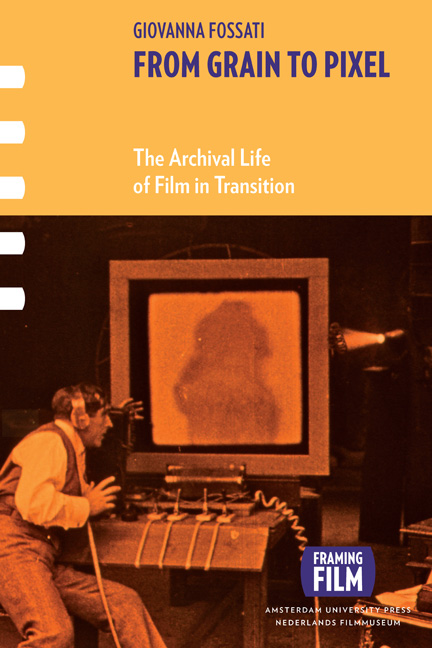Book contents
- Frontmatter
- Deduction
- Contents
- Acknowledgements
- Framing Film (in Transition): an Introduction
- Practice and Theory of (Archival) Film
- Theorizing (Archival) Practice
- A New Mindset for (Archival) Film in Transition: a Conclusion
- Notes
- Glossary Of Technical Terms
- List of Illustrations
- Filmography
- Bibliography
- Index
Chapter Three - Film Archival Field in Transition
Published online by Cambridge University Press: 16 February 2021
- Frontmatter
- Deduction
- Contents
- Acknowledgements
- Framing Film (in Transition): an Introduction
- Practice and Theory of (Archival) Film
- Theorizing (Archival) Practice
- A New Mindset for (Archival) Film in Transition: a Conclusion
- Notes
- Glossary Of Technical Terms
- List of Illustrations
- Filmography
- Bibliography
- Index
Summary
As I am investigating the interplay between theory and practice in this time of transition from analog to digital technology, in this chapter I will be looking at the field trying to determine how new frameworks and concepts, elaborated from film and media theory, can be related to the different approaches to film archival practice in transition identifiable in the field. This work, as I have earlier pointed out, not only looks at transition from analog to digital as its object of research, but its very perspective is positioned in transition. Therefore, I will look in the first place for variations and tensions between different players within a relatively compressed time frame (approximately from 1997 to 2008) with the goal to further portray a practice in transition.
In the following pages, I intend to sketch the social framing of the current transition in film archival practice. I will do so by briefly mapping the field of film archiving at large, pointing out “relevant social groups”, according to the terminology introduced by the Social Construction of Technology (SCOT) theory. The choice of calling upon some of the concepts introduced by the SCOT theory in this work has been mentioned earlier and is mainly based on the arguments that SCOT offers suitable tools for addressing a transitional process where a large number of players are involved and that, like other constructivist studies, rejects a deterministic approach to technology, making it particular relevant to this study.
SCOT's key concepts are those of “relevant social groups”, “technological frame” and “interpretive flexibility”, which in the following pages will be put in relation to the case of (archival) film. Its model, according to Bijker (2001: 15524), consists of three main research steps. In the first, an artifact is described based on the meaning given to it by relevant social groups interacting with the artifact. In the second step, the artifact's dominance over others is analyzed as a process of social construction, and, here, it is noted that the different meanings initially attributed to the artifact are reduced to a dominant one, causing its diminished interpretive flexibility. In the last step, the broader theoretical framework (or “technological frame”) is studied where the social process around an artifact takes place, looking at the dynamics among the relevant social group.
- Type
- Chapter
- Information
- From Grain to PixelThe Archival Life of Film in Transition, pp. 149 - 210Publisher: Amsterdam University PressPrint publication year: 2018



